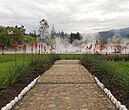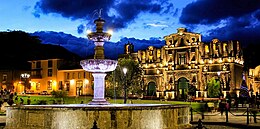
Back كاخاماركا (مدينة) Arabic كاخاماركا ARZ Qajamarka Aymara Кахамарка Byelorussian Кахамарка (горад) BE-X-OLD Кахамарка Bulgarian Cajamarca (ciutat del Perú) Catalan Cajamarca (kapital sa rehiyon) CEB Cajamarca Czech Кахамарка CV
Cajamarca | |
|---|---|
|
Clockwise from top: Partial view of the city, Nuestra Señora de la Piedad Church, Santa Catalina Church, Main Square, Los Baños del Inca and Ventanillas de Otuzco. | |
| Coordinates: 7°10′S 78°31′W / 7.167°S 78.517°W | |
| Country | |
| Region | Cajamarca |
| Province | Cajamarca |
| Founded | c. 1320 by pre-Columbian ethnic groups Spanish settlement in 1532 |
| Government | |
| • Mayor | Víctor Andrés Villar Narro (2019–2022) |
| Area | |
| • Total | 392.47 km2 (151.53 sq mi) |
| Elevation | 2,750 m (9,020 ft) |
| Population (2017) | |
| • Total | 201,329 |
| • Estimate (2020)[1] | 245,137 |
| • Density | 510/km2 (1,300/sq mi) |
| Demonym | Cajamarquino/a |
| Time zone | UTC-5 (PET) |
| Area code | 76 |
| Website | municaj.gob.pe |
Cajamarca (Spanish pronunciation: [kaxaˈmaɾka]), also known by the Quechua name, Kashamarka, is the capital and largest city of the Cajamarca Region as well as an important cultural and commercial center in the northern Andes. It is located in the northern highlands of Peru at approximately 2,750 m (8,900 ft) above sea level[2] in the valley of the Mashcon river.[3] Cajamarca had an estimated population of about 226,031 inhabitants in 2015, making it the 13th largest city in Peru.[1]
Cajamarca has a mild highland climate, and the area has very fertile soil. The city is well known for its dairy products and mining activity in the surroundings.[4][5]
Among its tourist attractions, Cajamarca has numerous examples of Spanish colonial religious architecture, beautiful landscapes, pre-Hispanic archeological sites and hot springs at the nearby town of Baños del Inca (Baths of the Inca). The history of the city is highlighted by the Battle of Cajamarca, which marked the defeat of the Inca Empire by Spanish invaders as the Incan emperor Atahualpa was captured and executed here.[6]
- ^ a b Perú: Estimaciones y Proyecciones de Población Total por Sexo de las Principales Ciudades, 2000 – 2015 (in Spanish). Lima: INEI. 2012. p. 17.
- ^ "Municipalidad Provincial de Cajamarca". Archived from the original on 22 June 2014. Retrieved 29 July 2014.
- ^ Tourist Climate Guide. SENAMHI. 2008. p. 55.
- ^ "Mantecoso Cheese in Peru". Publications.cirad.fr. Retrieved 18 January 2010.
- ^ "Cajamarca, Peru". Planeta.com. Archived from the original on 1 December 2009. Retrieved 18 January 2010.
- ^ "Battle of Cajamarca: Pizarro's Conquistadores Ambush, Capture Incan Emperor". The American Legion's Burnpit. Retrieved 26 July 2017.








